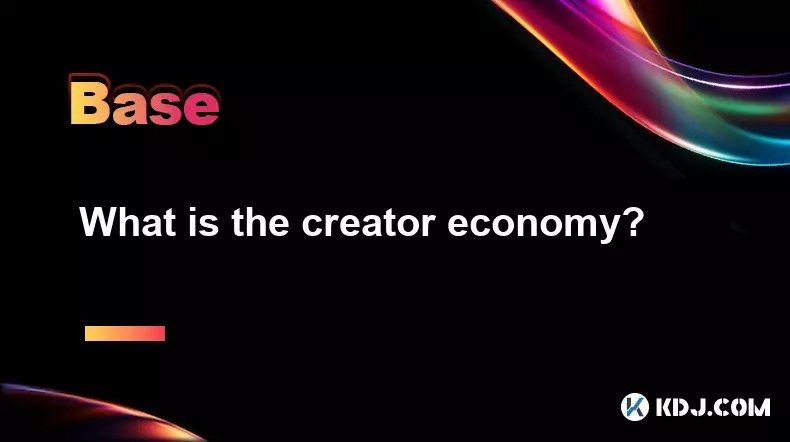-
 bitcoin
bitcoin $115469.758015 USD
0.29% -
 ethereum
ethereum $4536.640472 USD
-1.35% -
 xrp
xrp $2.998395 USD
-1.04% -
 tether
tether $1.000274 USD
-0.02% -
 bnb
bnb $921.981367 USD
-0.33% -
 solana
solana $235.464989 USD
-2.21% -
 usd-coin
usd-coin $0.999955 USD
0.02% -
 dogecoin
dogecoin $0.269732 USD
-2.68% -
 tron
tron $0.345815 USD
-0.84% -
 cardano
cardano $0.865586 USD
-2.26% -
 hyperliquid
hyperliquid $53.710810 USD
0.30% -
 chainlink
chainlink $23.619558 USD
-1.81% -
 ethena-usde
ethena-usde $1.001114 USD
-0.01% -
 sui
sui $3.539388 USD
-3.58% -
 avalanche
avalanche $29.724102 USD
1.08%
What is a crypto on-ramp?
A crypto on-ramp bridges fiat and digital currencies, enabling users to easily buy cryptocurrencies via trusted, regulated platforms.
Sep 10, 2025 at 05:54 pm

Understanding the Concept of a Crypto On-Ramp
1. A crypto on-ramp refers to a service or platform that enables users to convert traditional fiat currencies, such as USD or EUR, into cryptocurrencies like Bitcoin or Ethereum. These services act as gateways, bridging the gap between conventional financial systems and digital asset ecosystems. They are essential for new users who are entering the crypto space and need a reliable method to acquire digital assets.
2. On-ramps typically integrate with banks, payment processors, or card networks to facilitate seamless transactions. Users can link their bank accounts, use debit or credit cards, or even leverage mobile payment solutions to fund their purchases. The process is designed to be user-friendly, often completed within minutes, depending on the verification and transaction speed.
3. Regulatory compliance is a major component of crypto on-ramps. These platforms are required to implement Know Your Customer (KYC) and Anti-Money Laundering (AML) procedures to verify user identities and prevent illicit activities. This adds a layer of security and legitimacy, making on-ramps trusted entry points for mainstream users.
4. Popular examples include services offered by exchanges like Coinbase, Binance, and Kraken, as well as third-party providers such as MoonPay, Ramp Network, and Transak. These platforms support a wide range of cryptocurrencies and fiat currencies, increasing accessibility across different regions.
5. The efficiency and cost of using an on-ramp vary based on the provider, payment method, and jurisdiction. Some charge higher fees for instant card purchases, while bank transfers may be cheaper but slower. Users often compare options to find the best balance between speed, cost, and convenience.
Key Features of Effective On-Ramp Solutions
1. Seamless integration with wallets and decentralized applications (dApps) is a hallmark of modern on-ramp services. Users can purchase crypto directly within a Web3 wallet interface without leaving the app, enhancing the user experience and reducing friction.
2. Support for multiple payment methods increases accessibility and inclusivity. Leading on-ramps accept credit and debit cards, bank transfers, Apple Pay, Google Pay, and even local payment systems in emerging markets, ensuring broader global reach.
3. Real-time transaction processing and instant crypto delivery are critical for maintaining user trust. Delays in receiving purchased assets can lead to frustration, especially during volatile market conditions when prices change rapidly.
4. Transparent fee structures help users make informed decisions. Hidden charges or unclear pricing models can deter adoption. Reputable on-ramps display all fees upfront, including network and service charges.
5. Strong security protocols, including end-to-end encryption and two-factor authentication, protect users’ financial and personal data. Given the sensitivity of financial transactions, security is a non-negotiable feature for any on-ramp provider.
Impact on Crypto Adoption and Market Dynamics
1. Crypto on-ramps play a pivotal role in driving mainstream adoption by simplifying the initial entry process. By reducing technical barriers, they enable individuals with little to no blockchain knowledge to participate in the digital economy.
2. Increased liquidity in the crypto market is a direct result of efficient on-ramping. As more fiat capital flows into digital assets, trading volumes rise, contributing to market stability and depth.
3. On-ramps also influence price discovery, especially during periods of high demand. Sudden surges in fiat inflows through on-ramps can signal bullish sentiment and trigger price movements across major cryptocurrencies.
4. Geographic expansion of on-ramp services supports financial inclusion in underbanked regions. Users in countries with limited access to traditional banking can leverage mobile-based on-ramps to gain exposure to global digital assets.
5. Partnerships between on-ramp providers and fintech companies are accelerating innovation. Embedded finance models allow non-crypto platforms to offer crypto purchasing options, further blurring the lines between traditional and decentralized finance.
Frequently Asked Questions
What is the difference between a crypto on-ramp and off-ramp?A crypto on-ramp allows users to buy cryptocurrencies using fiat money, while an off-ramp enables the conversion of cryptocurrencies back into fiat currency, which can then be transferred to a bank account.
Are crypto on-ramps safe to use?Reputable on-ramp services implement strict security and compliance measures, including KYC checks and encryption. However, users should verify the legitimacy of the platform and avoid sharing sensitive information on untrusted websites.
Why do some on-ramps charge higher fees?Fees vary based on payment method, processing speed, and operational costs. Card-based purchases usually incur higher fees due to payment network charges, whereas bank transfers are often cheaper but slower.
Can I use a crypto on-ramp without verification?Most regulated on-ramps require identity verification to comply with legal standards. However, some decentralized or peer-to-peer platforms may allow limited transactions without full KYC, though with lower purchase limits.
Disclaimer:info@kdj.com
The information provided is not trading advice. kdj.com does not assume any responsibility for any investments made based on the information provided in this article. Cryptocurrencies are highly volatile and it is highly recommended that you invest with caution after thorough research!
If you believe that the content used on this website infringes your copyright, please contact us immediately (info@kdj.com) and we will delete it promptly.
- MoonBull, Meme Coins, and Turbo: What's the Hype?
- 2025-09-16 10:25:13
- Ripple's RLUSD: A $25 Million Boost for Veterans and Small Businesses
- 2025-09-16 10:25:13
- Major Token Unlocks Incoming: ZRO and More!
- 2025-09-16 10:30:01
- Bitcoin Price Prediction: Will Remittix Trending Affect BTC's Next Move?
- 2025-09-16 09:10:01
- BONK Price, Fed Meeting, and Elliott Wave: What's Next?
- 2025-09-16 09:10:01
- Base Blockchain, Network Token, and Coinbase Expansion: What's the Buzz?
- 2025-09-16 08:25:12
Related knowledge

What is the creator economy?
Sep 10,2025 at 02:54am
Understanding the Creator Economy in the Digital Age1. The creator economy refers to a digital ecosystem where individuals produce content, build audi...

What is social recovery for wallets?
Sep 09,2025 at 09:54am
Understanding Social Recovery in Cryptocurrency Wallets1. Social recovery is a security mechanism designed to help users regain access to their crypto...

What is a crypto payment gateway?
Sep 14,2025 at 06:36pm
Understanding the Role of a Crypto Payment Gateway1. A crypto payment gateway is a technological solution that enables merchants to accept digital cur...

What is DeFiLlama?
Sep 10,2025 at 09:18am
What Is DeFiLlama and Why It Matters in the Crypto Space1. DeFiLlama is a data analytics platform that focuses on decentralized finance (DeFi) protoco...

What is CoinGecko?
Sep 11,2025 at 06:18am
What is CoinGecko?CoinGecko is a cryptocurrency data aggregator that provides real-time information on digital asset prices, trading volumes, market c...

How is crypto regulated?
Sep 10,2025 at 04:18pm
Understanding the Framework of Crypto Regulation1. Governments and financial authorities around the world have taken varied approaches to regulating c...

What is the creator economy?
Sep 10,2025 at 02:54am
Understanding the Creator Economy in the Digital Age1. The creator economy refers to a digital ecosystem where individuals produce content, build audi...

What is social recovery for wallets?
Sep 09,2025 at 09:54am
Understanding Social Recovery in Cryptocurrency Wallets1. Social recovery is a security mechanism designed to help users regain access to their crypto...

What is a crypto payment gateway?
Sep 14,2025 at 06:36pm
Understanding the Role of a Crypto Payment Gateway1. A crypto payment gateway is a technological solution that enables merchants to accept digital cur...

What is DeFiLlama?
Sep 10,2025 at 09:18am
What Is DeFiLlama and Why It Matters in the Crypto Space1. DeFiLlama is a data analytics platform that focuses on decentralized finance (DeFi) protoco...

What is CoinGecko?
Sep 11,2025 at 06:18am
What is CoinGecko?CoinGecko is a cryptocurrency data aggregator that provides real-time information on digital asset prices, trading volumes, market c...

How is crypto regulated?
Sep 10,2025 at 04:18pm
Understanding the Framework of Crypto Regulation1. Governments and financial authorities around the world have taken varied approaches to regulating c...
See all articles










































































